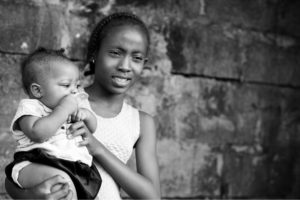A new UN report has received a lot of media attention, with multiple articles claiming that low fertility rates present a “crisis,” and that people around the world are having fewer children than they desire. This unfortunate framing obscures a far more serious crisis: around half of all pregnancies across the world are unintended, and too many women still have no say over what happens to their bodies.
State of World Population 2025
The United Nations Population Fund (UNFPA) State of World Population 2025 report, argues that the “real fertility crisis” is neither high birthrates, nor low birthrates, but people not feeling able to have the number of kids they would like to have. Like previous editions, this year’s report criticizes both concern about overpopulation and underpopulation, claiming that focusing on numbers of people is harmful to reproductive rights, and condemning policies that aim to increase or decrease birthrates without regard to people’s circumstances and desires.
[While we fully agree that governments should pursue bodily autonomy and reproductive agency rather than specific fertility targets, we believe that ignoring the impacts of population growth does more damage than good, and that drawing the links between population, health, and environment is key to achieving the Sustainable Development Goals.]
 The report mentions the problem of unintended pregnancy and that “despite significant advances in sexual and reproductive health and rights, the most marginalized people have experienced the fewest gains.” It points out that an estimated 44 percent of women and girls worldwide still do not have decision-making power or bodily autonomy regarding sexual relations, contraceptive use, and reproductive healthcare. The report also highlights that nearly one in five girls are married off before turning 18, and that gender-based violence remains one of the most pervasive human rights violations, affecting one in three women worldwide.
The report mentions the problem of unintended pregnancy and that “despite significant advances in sexual and reproductive health and rights, the most marginalized people have experienced the fewest gains.” It points out that an estimated 44 percent of women and girls worldwide still do not have decision-making power or bodily autonomy regarding sexual relations, contraceptive use, and reproductive healthcare. The report also highlights that nearly one in five girls are married off before turning 18, and that gender-based violence remains one of the most pervasive human rights violations, affecting one in three women worldwide.
A large part of this report, however, focuses on barriers to having children. The authors argue that people having fewer than their ideal number of kids is also a “crisis.” This was the aspect of the report that media stories highlighted, while sadly neglecting the more serious problem of persistent rights violations and lack of bodily autonomy.
The State of World Population 2025 report lays out the results of a survey conducted by YouGov on behalf of UNFPA of 14,000 people across 14 countries with fertility rates ranging from ultra-low (South Korea) to high (Nigeria), and representing over 37 percent of the world’s population. The survey was similar to a Population Connection one whose results we published earlier this year, in which we asked US adults about their actual vs. desired number of children, as well as about the limiting factors that influenced their childbearing outcomes.
Survey findings
Fertility desires vs. expectations and outcomes
On average, for all reproductive-age adults across UNFPA’s 14 study countries, 37 percent said they expected to achieve their ideal number of children, 11 percent said they believed they would have fewer than they would ideally choose, and 7 percent believed they would have more. Another 45 percent did not know or did not want to say.
For respondents aged 50 and older (who are presumed to have completed their childbearing), a plurality — 38 percent — reported having achieved their ideal number of children, while 31 percent said they had fewer kids than they desired, and 12 percent said they had more than they desired. Just under a fifth (19 percent) said they did not know or did not want to say.
Across respondents of all ages, almost a third (32 percent) said they or their partner had experienced an unintended pregnancy.
The survey also asked people if they had experienced wanting a child but feeling unable to fulfill that desire at the preferred time. Nearly a quarter (23 percent) said yes, and 40 percent of these said they had to ultimately forgo their desire to have a child.
In two countries, Morocco and South Africa, a high proportion said they or their partner experienced both unintended pregnancy (around half) and inability to have a child at their preferred time (over 30 percent).
Barriers to fulfilling desired family size
When asked what factors have led or are likely to lead to them having fewer children than they initially desired, by far the most cited reason was financial limitations, with 39 percent of respondents across all countries who reported having or wanting to have children selecting this factor. The proportion of people citing financial limitations as a barrier was highest in South Korea (the country with the world’s lowest fertility rate, at just 0.8 births per woman), at 58 percent. Affordability was also one of two top factors cited by US adults in our survey (the other being concern over the state of the world).
 In the UNFPA survey, the second most commonly reported factor across all countries, at 21 percent, was unemployment or job insecurity, followed by housing limitations, at 19 percent. For unemployment and job insecurity, Thailand and South Africa had the highest proportion of people citing this factor (both at 33 percent), while for housing limitations, it was South Korea (21 percent).
In the UNFPA survey, the second most commonly reported factor across all countries, at 21 percent, was unemployment or job insecurity, followed by housing limitations, at 19 percent. For unemployment and job insecurity, Thailand and South Africa had the highest proportion of people citing this factor (both at 33 percent), while for housing limitations, it was South Korea (21 percent).
Concerns over the state of the world did not rank as highly as in our survey, with 14 percent of respondents citing concerns about political or social situations, and 9 percent citing concerns about climate change or environmental degradation. Thailand had the highest proportion of people saying concerns about political or social situations (23 percent) and the environment (18 percent) have led or are likely to lead to them having fewer children than they initially desired.
How many kids do people actually desire?
Across every country, the most common desired number of children was two — 38 percent of all women and 35 percent of all men said this would be the number of children they would ideally have. This matches what we found for US adults in our survey, but it is surprising that the UNFPA survey found two kids to be the most popular desired family size in countries with high fertility rates also, as previous survey work had shown desired fertility to be higher in these nations.
Nigeria, for example, has a fertility rate of 4.3 births per woman, yet in the UNFPA survey, only 21 percent of women said they desire four or more kids, while 34 percent desire two. In high-fertility countries like Nigeria, there is a big gender difference regarding desired fertility — 32 percent of Nigerian men in the survey said they desired four or more kids, while only 20 percent said they would ideally have two children.
Two kids was overwhelmingly the most desired family size in South Korea too, with 42 percent of men and 40 percent of women choosing this as their ideal number, demonstrating a large gap between desired and actual fertility in this country also.
Overall, on average across countries and genders, three kids was the second most popular desired family size (15 percent of both men and women), followed by one child (11 percent of men and 9 percent of women), then four or more children (10 percent of men and 11 percent of women). The smallest proportion of people said they do not desire any children (7 percent of men and 8 percent of women).
The “real” crisis?
The language used in this report makes it look (perhaps inadvertently) like UNFPA is arguing that people having fewer than their ideal number of children is a “fertility crisis” on par with women having no say over their bodies and being forced to bear children.
While we must absolutely urge governments to work on removing the barriers that prevent people from having as many kids as they desire, such as economic uncertainty and poor welfare, empowering everyone to have bodily autonomy and access to contraception should still be the priority. Unlike lower-than-desired fertility, unintended pregnancy and forced birth can cause preventable death and grievous suffering, and can trap families in poverty.
If, on average, two kids really is the most preferred family size across the world, then our current global fertility rate of 2.2 births per woman still reflects more unintended births than smaller-than-desired families.
Improving reproductive agency is not only essential to fulfilling people’s rights and desires — it would also allow populations to stabilize, reducing the unsustainable pressures created by ever more people on already overburdened environments, infrastructure, and public services, which, in fragile states, also present real threats to peace, security, and prosperity.
This blog post only scratches the surface of the wealth of interesting information covered in the State of World Population 2025 report, which also delves in detail into the many complex and evolving factors behind declining birthrates. We recommend reading it for yourself, and feel free to let us know what stood out to you.


 The report mentions the problem of unintended pregnancy and that “despite significant advances in sexual and reproductive health and rights, the most marginalized people have experienced the fewest gains.” It points out that an estimated 44 percent of women and girls worldwide still do not have decision-making power or bodily autonomy regarding sexual relations, contraceptive use, and reproductive healthcare. The report also highlights that nearly one in five girls are married off before turning 18, and that gender-based violence remains one of the most pervasive human rights violations, affecting one in three women worldwide.
The report mentions the problem of unintended pregnancy and that “despite significant advances in sexual and reproductive health and rights, the most marginalized people have experienced the fewest gains.” It points out that an estimated 44 percent of women and girls worldwide still do not have decision-making power or bodily autonomy regarding sexual relations, contraceptive use, and reproductive healthcare. The report also highlights that nearly one in five girls are married off before turning 18, and that gender-based violence remains one of the most pervasive human rights violations, affecting one in three women worldwide. In the UNFPA survey, the second most commonly reported factor across all countries, at 21 percent, was unemployment or job insecurity, followed by housing limitations, at 19 percent. For unemployment and job insecurity, Thailand and South Africa had the highest proportion of people citing this factor (both at 33 percent), while for housing limitations, it was South Korea (21 percent).
In the UNFPA survey, the second most commonly reported factor across all countries, at 21 percent, was unemployment or job insecurity, followed by housing limitations, at 19 percent. For unemployment and job insecurity, Thailand and South Africa had the highest proportion of people citing this factor (both at 33 percent), while for housing limitations, it was South Korea (21 percent).
